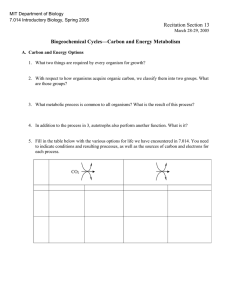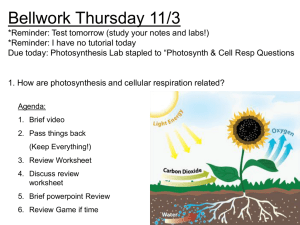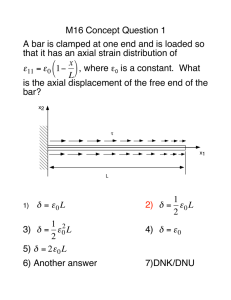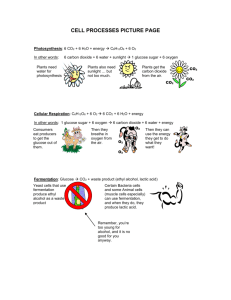Recitation Section 13 Answer Key Biogeochemical Cycles—Carbon and Energy Metabolism
advertisement
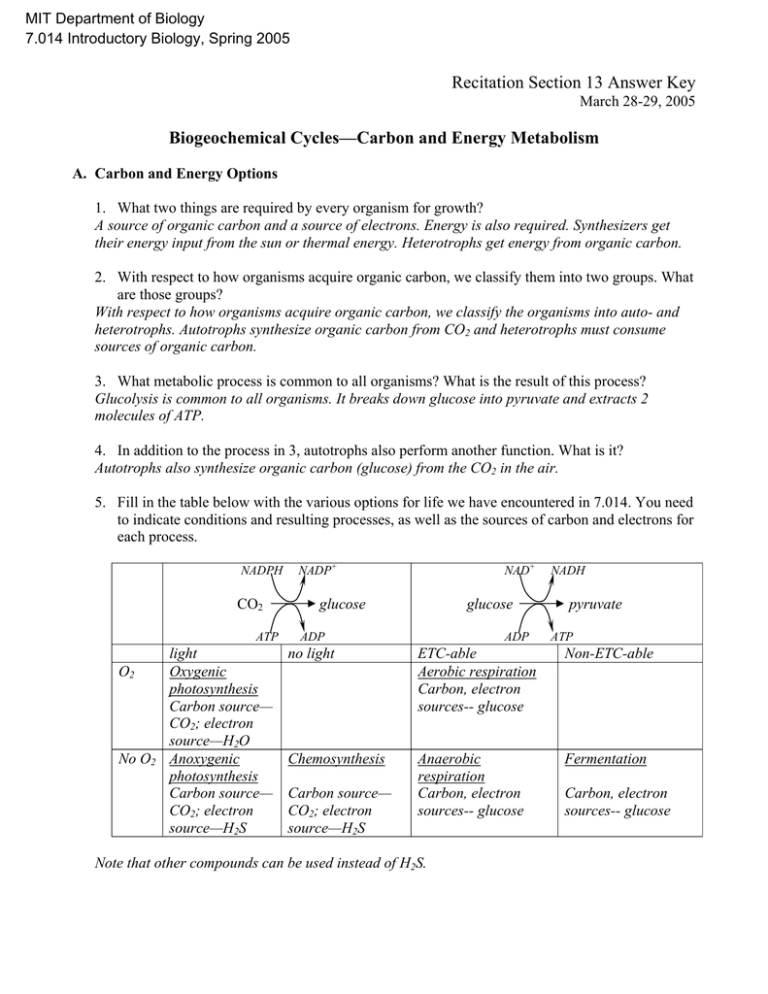
MIT Department of Biology 7.014 Introductory Biology, Spring 2005 Recitation Section 13 Answer Key March 28-29, 2005 Biogeochemical Cycles—Carbon and Energy Metabolism A. Carbon and Energy Options 1. What two things are required by every organism for growth? A source of organic carbon and a source of electrons. Energy is also required. Synthesizers get their energy input from the sun or thermal energy. Heterotrophs get energy from organic carbon. 2. With respect to how organisms acquire organic carbon, we classify them into two groups. What are those groups? With respect to how organisms acquire organic carbon, we classify the organisms into auto- and heterotrophs. Autotrophs synthesize organic carbon from CO2 and heterotrophs must consume sources of organic carbon. 3. What metabolic process is common to all organisms? What is the result of this process? Glucolysis is common to all organisms. It breaks down glucose into pyruvate and extracts 2 molecules of ATP. 4. In addition to the process in 3, autotrophs also perform another function. What is it? Autotrophs also synthesize organic carbon (glucose) from the CO2 in the air. 5. Fill in the table below with the various options for life we have encountered in 7.014. You need to indicate conditions and resulting processes, as well as the sources of carbon and electrons for each process. NADPH CO2 ATP O2 No O2 light Oxygenic photosynthesis Carbon source— CO2; electron source—H2O Anoxygenic photosynthesis Carbon source— CO2; electron source—H2S NADP+ NAD+ glucose glucose ADP ADP NADH pyruvate ATP no light ETC-able Aerobic respiration Carbon, electron sources-- glucose Non-ETC-able Chemosynthesis Anaerobic respiration Carbon, electron sources-- glucose Fermentation Carbon source— CO2; electron source—H2S Note that other compounds can be used instead of H2S. Carbon, electron sources-- glucose B. Problem Solving As an aspiring biogeochemist, you set out on an ambitious search for previously uncharacterized microorganisms. You go down to your local swamp and return with 3 different bacteria. You’re not sure what these bacteria need in order to grow, but since the swamp is pretty stinky you try growing them under anaerobic conditions in buffered water that has CO2 and H2S bubbled through it. You grow the three bacterial species in both the light and in the dark and observe the following. species #1 species #2 species #3 dark grows NO growth NO growth light grows grows NO growth 1. From this data, you conclude that strain #1 is a chemosynthetic autotroph. i) What is the source of electrons for this metabolism? H2S ii) What is the source of carbon for this metabolism? CO2 2. What type of metabolism does strain #2 employ to make energy? Anoxygenic photosynthesis i) What is the source of electrons for this metabolism? H2S ii) What is the source of carbon for this metabolism? CO2 3. You put strain #3 together with strain #1 under anaerobic conditions in water that has CO2 and H2S bubbled through it (the same conditions as above). Now both strain 1 and strain 3 grow in the light and in the dark. i) What type of metabolism used by strain #3? Anaerobic respiration ii) In strain #3, what is the source of electrons for this metabolism? Glucose or NADH iii) In strain #3, what is the final electron acceptor for this metabolism? S 4. Done with your experiment, you stop bubbling CO2 and H2S through the water after a day of growing species #1 and species #3 together. Surprisingly, both #1 and #3 continue growing indefinitely. Explain this observation. What strain #1 needs, CO2 and H2S, is produced by strain #3. What strain #3 needs, glucose (or fixed carbon) and S, is produced by strain #1. In 1640 Jan Baptista van Helmont, a Flemish physician and chemist, carried out the following experiment about plant growth: He took a pot of soil, and weighed the soil. He then took a willow sapling and weighed it. He planted the sapling and watered the plant for 5 years. After that time, he weighed the willow tree and he weighed the remaining soil. These were his observations: plant soil upon planting 5 lb 200 lb 5 years later 174 lb difference +169 lb 5. By how much do you suspect the weight of the soil decreased? Why? 90% (180 lbs) 85% (170 lbs) 50% (100 lbs) 10% (20 lbs) 1% (2 lbs) 0.1% (0.2 lbs) 0.01% (0.02 lbs) The mass of the plant came primarily from the fixed carbon that the plant produced from CO2 via photosynthesis. 6. Bacteria that use O2 as an electron acceptor in respiration produce more ATP per molecule of glucose than those that use NO3- as an electron acceptor. Explain why. O2 is a better electron acceptor than NO3-. As more electrons are transported, more H+ ions are transported, and thus more ATP can be made.
